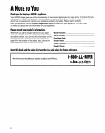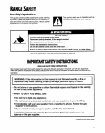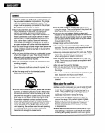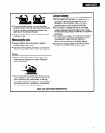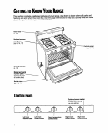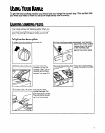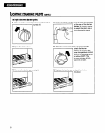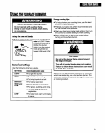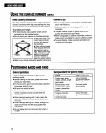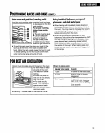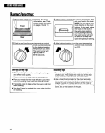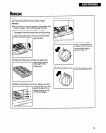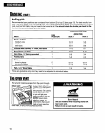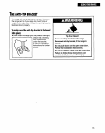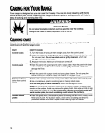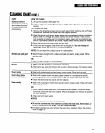
Home canning information
Cookware tips
The large diameter of most water-bath or pressure
canners combined with high heat settings for long
periods of time can cause damage to the cooktop.
To protect your range:
l
For best results, use a canner which can be
centered over the surface burner.
l
Do not place your canner on 2 surface burners
l
The pan should have a flat bottom, straight sides,
and a well-fitting lid.
0 Choose medium to heavy gauge (thickness)
cookware.
at the same time. Too
much heat will build
up and will damage
the cooktop.
l
Start with hot water.
This reduces the time
the control is set on
high. Reduce the heat
setting to the lowest
position needed to
keep the water boiling.
0 The pan material (metal or glass) affects how
quickly and evenly the pan heats.
l
When using glass or ceramic cookware, check to
make sure it is suitable for use on surface burners.
0 To avoid tipping, make sure pots and pans are
centered on the grates.
l
Refer to your canner manual for specific instructions.
USING ME SURFACE BURNERS (CONT.)
General guidelines
Follow this section carefully to get the best
cooking results.
l
Before turning on the oven, place oven racks
where you need them.
l
To move a rack, pull it out to the stop, raise the
front edge, and lift it out.
0 Be sure the rack(s) is level.
0 Use pot holders or oven mitts to protect your
hands if rack(s) must be moved while the
oven is hot.
l
When baking/roasting with 1 rack, place the
rack so the top of the food will be centered in
the oven.
l
When baking/roasting on 2 racks, arrange the
racks on the 2nd and 4th rack guides from
the bottom.
l
Do not place items on the oven door when it
is open.
Rack Placement for specific foods:
POSITIONING RACKS
AND PANS
FOdD
I
RACK POSITION
Frozen pies, large
roasts, turkeys, angel
food cakes
1 st or 2nd rack
guide from bottom
Bundt cakes, most
quick breads, yeast
breads, casseroles,
meats
2nd rack guide
from bottom
Cookies, biscuits,
muffins, cakes,
nonfrozen pies
2nd or 3rd rack
guide from bottom
10



